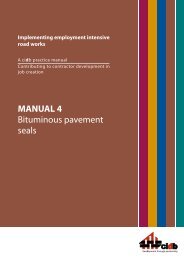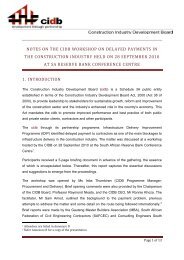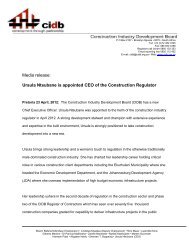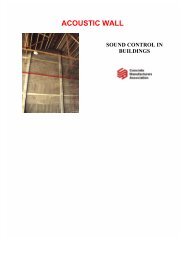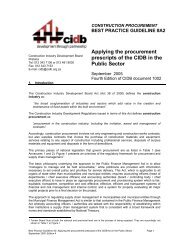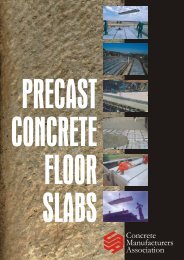Clay brick manufacture - Construction Industry Development Board
Clay brick manufacture - Construction Industry Development Board
Clay brick manufacture - Construction Industry Development Board
You also want an ePaper? Increase the reach of your titles
YUMPU automatically turns print PDFs into web optimized ePapers that Google loves.
Part 4<br />
ACCOMMODATION OF MOVEMENT<br />
4.1 OVERALL MOVEMENT<br />
All buildings are subjected to varying degrees of dimensional change after being built. Many factors<br />
affect movement, such as the temperature and moisture changes of the surrounding atmosphere, the<br />
characteristics of the masonry and mortar, the degree of restraint imposed by foundations, roof<br />
trusses and suspended slabs, and the imposed loads on the walls.<br />
In general, it is simpler to adopt empirical rules rather than to try and estimate movement in a building<br />
from first principles. SABS 0249: Masonry Walling has a section on movement in masonry.<br />
4.2 THERMAL MOVEMENT<br />
An increase in the temperature of a wall will induce expansion. The degree of movement is equal to the<br />
temperature range multiplied by the appropriate coefficient of thermal movements overcoming restraint<br />
in the wall itself (see Table 3). A decrease in temperature will result in the shortening of the wall that<br />
may induce cracks. However, the movement that actually occurs within a wall after construction depends<br />
not only on the range of temperatures, but also on the initial temperatures of the units as laid, their<br />
moisture content and the degree of restraint. To determine the effective free movement that could<br />
occur, therefore, some estimation of the initial temperature and temperature range has to be made. The<br />
effective free movement that is calculated should still be modified to allow for the effects of restraints.<br />
Table 3: Linear thermal movement of masonry units<br />
and mortar<br />
Material Coefficient of linear Movement per 10 m<br />
Burnt clay masonry units<br />
4.3 IRREVERSIBLE MOISTURE EXPANSION MOVEMENT<br />
(refer to section 3.5)<br />
The continuing expansion of <strong>brick</strong>s justifies earlier recommendations to avoid problems in buildings.<br />
Building problems caused by the expansion of <strong>brick</strong>s can be avoided by using mortar that can<br />
accommodate at least some of the expansion, avoiding designs such as short offsets in long runs of<br />
<strong>brick</strong>work, and by incorporating adequate movement joints.<br />
thermal movement of wall for 50˚C<br />
per degree ˚C x 10 -6 temperature change<br />
15<br />
(mm)<br />
(see note 1) 4 – 8 2 – 4<br />
Concrete masonry units<br />
(see note 2) 7 – 14 3,5 – 7<br />
Mortars 11 – 13 5,5 – 6,5<br />
Notes:<br />
1) Thermal movement of burnt clay masonry units depends on the clay mixture and its firing.<br />
2) Thermal movement of concrete masonry units depends on the type of aggregate and the mix proportions.





